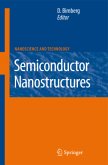The general trend in modern solid state physics and technology is to make things smaller. The size of key elements in modern devices approaches the nanometer scale, for both vertical and lateral dimensions. Ultrathin layers, or quantum wells, had already gained broad acceptance for applications in micro- and optoelectronics by the 1980s. However, the development of het erostructures with lower dimensionality (quantum wires, where carriers are confined in two directions and move freely in one, and quantum dots, where carriers are confined in all three directions) took longer. It became clear that quantum wire and dot structures constitute the utmost technological chal lenge, whilst providing enormous advantages. At the beginning of the 1990s, a few outstanding discoveries concern ing self-organization phenomena at crystal surfaces for direct fabrication of nanostructures led to a change in the major paradigms of semiconductor physics and technology. This new approach in epitaxy enables fast parallel fabrication of large densities of quantum dots or wires for almost unlimited material combinations and has become the basis for a powerful new branch of nanotechnology. Quantum dots, coherent inclusions in a semiconductor ma trix with zero-dimensional electronic properties persistent up to room tem perature, have demonstrated fascinating physical properties and given birth to a novel generation of optoelectronic devices and systems.
From the reviews: "The book focuses on the physical mechanisms behind the spontaneous formation of ordered nanostructures ... . The list of chapters give a good indication on the points of view of the authors. ... Most books on nanophysics deal with isolated nanosystems, or nanosystems in solutions. This one gives a good overview of deposited nanostructures. It will then be helpful to researchers working or entering the specific field of research, but also to people coming from the thin films or interface fields." (Michel Wautelet, Physicalia, Vol. 57 (3), 2005) "This monograph is a detailed account of the theory and practice of growth, characterization and applications of quantum-dot nanostructures (of mainly compound semiconductors) in real devices, written by a group of leading experts in the field ... which makes it an invaluable asset in any nanostructure-growth laboratory. ... this monograph, aimed at the postgraduate and specialist level, is excellent on so many levels that I strongly recommend it to scientists engaged in nanostructure research and to those who consider entering this fascinating field." (Dr I. O. Goldfarb, Contemporary Physics, Vol. 46 (3), 2005) "This book is intended to explain to at least a postgraduate and above, the mechanisms, growth processes, analytical characterisation techniques and, ultimately, the potential areas of application of epitaxial nanostructures ... . this book makes a very informative introduction and guide to the complex world of epitaxial nanostructures and is well worth the asking price." (Paul Cannard, Materials World, Vol. 13 (2), February, 2005)








